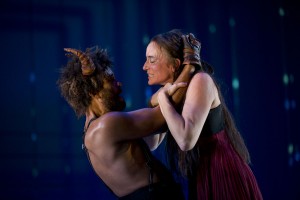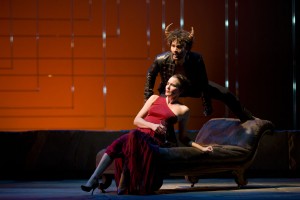Phaedra is a character with demons. Resonating over thousands of years of mythology and dramatic tradition, those demons have found their way to the stage of Princeton’s McCarter Theatre where they are demanding answers. McCarter’s world premiere of acclaimed Irish playwright Marina Carr’s daring new play, PHAEDRA BACKWARDS, rises to the challenge of these ghosts, offering them the reckoning they demand while assertively situating itself within a powerful lineage.

Julio Monge as Minotaur, Phaedra’s half-brother and Stephanie Roth Haberle as Phaedra in PHAEDRA BACKWARDS running at McCarter Theatre in Princeton NJ through November 11. (Photo credit: T. Charles Erickson)
The Phaedra myth is an archetypal story of a love triangle, its points populated by a father, his son, and a woman who is a new wife to the father and a stepmother to the son; the monuments of this story’s dramatic lineage are the Greek Euripides, Roman Seneca, and the seventeenth-century Frenchman Jean Racine. The myth’s basic structure shows us Phaedra newly married to Theseus, but overcome by a burning lust for his son and her stepson, Hippolytus. Racked by a lust she knows is taboo, Phaedra attempts to conceal her desires, but fails for various reasons. Once the scandal comes to light, Theseus banishes Hippolytus, who quickly dies, and Phaedra kills herself in shame and disgrace. It is a tragedy of lust, taboo, anger, and jealousy that proves timely again and again.
Adaptations of the Phaedra myth are unfamiliar neither to Irish drama nor the contemporary American stage. Brian Friel, Ireland’s most renowned playwright, adapts the story for his 1977 play Living Quarters, and theaters in New York have recently staged two American versions: a revival of Eugene O’Neill’s Desire Under the Elms, and Suzan-Lori Parks’s brand new The Book of Grace, both of which reimagine the Phaedra myth for their own time and place. Given such a preeminence of this myth and its treatment by such major figures of the theater, it may seem daunting or even inadvisable for Ms. Carr and the McCarter to tackle the story again themselves. The ghosts of the Greek imagination moan with a new vigor in our contemporary moment, and to call them forth now requires courage and audacity.
But Marina Carr has never been afraid of ghosts.
PHAEDRA BACKWARDS wrangles theses demons into courageously unique new terrain, not adapting or retelling any of its major predecessors, but bringing fresh eyes to an ancient and well-worn story. Whereas most adapters of the Phaedra myth are drawn to its central love triangle, Ms. Carr asks startlingly new questions of her subject—startling both for their insight and for the simple fact that nobody has previously seemed interested in asking them at all. In this play, Ms. Carr is set on investigating all the sordid tensions and details that others are content to leave to the love triangle’s prehistory.
For, Phaedra’s story begins well before her doomed lust for Hippolytus. She is the daughter of Pasiphae, a woman who goes to great lengths to consummate her cursed lust for a bull, ultimately giving birth to the half-man, half-bull Minotaur. Phaedra and her sister Ariadne are thus half-siblings to the Minotaur, who is ultimately slayed by Theseus, the man who woos and abandons Ariadne, and then marries Phaedra. Ariadne kills herself after Theseus leaves her, and the Minotaur dies on the edge of his sword; Phaedra is thus married to the man responsible for the death of both her siblings.

Stephanie Roth Haberle and Julio Monge star in McCarter Theatre's PHAEDRA BACKWARDS, directed by Emily Mann. (Photo credit: T. Charles Erickson)
The great contribution of PHAEDRA BACKWARDS to its mythical lineage is its direct encounter with these too-long ignored forces underlying the tragedy. This is a play far less concerned with catastrophe than it is with causes, and much less invested in the dénouement than it is in investigating and giving definition to the dramatic arc precipitating tragic consequences. As its title suggest, this play begins at the end, with a scene between Theseus and Phaedra upon hearing the news of Hippolytus’ death; while Theseus is distraught and exasperated, Phaedra is measured, accepting, and drunk. Suffering like this is nothing new for somebody who has lived through the gruesome deaths of her entire immediate family, and so our first image of Phaedra is of a woman greeting turmoil by resigning herself to the burden of interminable suffering.
Ms. Carr is no stranger to Greek stories, but when she has written versions of Greek heroines in the past—most notably adapting Medea’s story for By the Bog of Cats… (1998) and Iphigenia’s for Ariel (2002)—she has done so by updating the names and stories to a contemporary Irish context. Her greatest successes have been plays set in the Irish Midlands that examine the tenuous lives of female characters reckoning with the pain of their pasts and their current demons, all within the powerfully spiritual and mythic framework of the Greeks. PHAEDRA BACKWARDS is thus a departure that finds Ms. Carr meeting the Greeks on their own turf. The play’s timeframe may be updated to a period of tuxedoes and cellphones, but little is obscured in allegory or intertextuality. Unlike Ms. Carr’s earlier tendencies, and unlike the strategies of O’Neill and Parks, the dramaturgy of PHAEDRA BACKWARDS situates the play directly within classical myth, and endeavors to investigate more deeply the tensions and struggles of this familiar character.
Played with masterful nuance by Stephanie Roth Haberle, this Phaedra is defined much less by her current dangerous lust than she is by a lifetime wading through sorrow. When she brags brashly about her capacity for suffering, she underscores this play’s primary focus: Phaedra as a long-suffering woman, beset by the weight of a haunting lineage and torturous desires, struggling to find purpose in day-to-day psychological turmoil. Ms. Roth Haberle’s task is thus greatly challenging, and her success most impressive. She must find space for psychological and emotional tension within a character so abandoned to her suffering that her life—her time spent before the McCarter’s audience—seems to her in large part pointless.
Putting on a rough exterior for Phaedra’s living family, Ms. Roth Haberle finds space for that nuance most directly in her character’s haunting memories. Phaedra becomes most human for us at the points in the play when filmed scenes of her childhood memories are projected on the stage’s rear wall. There we see her as a small child, playing in the fields with her sister and her half-brother, the Minotaur as a child of about six, complete with tail, hooves, and horns. In these and other moments when Phaedra must stare into or at her family history, Ms. Roth Haberle lets the rough exterior crumble, allowing us to see a wholly unique Phaedra, one racked not by lust but by fading memories of a time of tenderness and joy, and reminders of her place in the aftermath of that joy. To be sure, this Phaedra is straight out of Ms. Carr’s great Midlands plays. Like Hester Swane and Portia Coughlan before her, this Phaedra exists in a context defined by ghosts of the past, hostility of the present, and an unshakeable pull towards truly deep suffering. Phaedra’s lust for Hippolytus may be an important plot element to this play, but it is far from her defining tension. Ms. Carr has reexamined Phaedra with an eye to the greater depth and dimension of her struggles.
The same is true of the play’s other characters, particularly the long-neglected Pasiphae and Minotaur. To stage these characters as objects of pathos is a daring move by PHAEDRA BACKWARDS, and it does so with great aplomb. In one scene, we see Pasiphae not as the woman of unthinkable lust, but as a staunch defender of her motherly love, rescuing the young Minotaur from her husband’s murderous grasp and passionately professing her maternal care for him. The full-grown Minotaur, played by Julio Monge, who returns regularly to the stage from the land of death, is a remarkable achievement. Subtly costumed with horns, a tail, and gloves suggesting hooves, this Minotaur congers a depth and pity all but unthinkable of his mythological predecessor. Not shying away from the character’s beastly urges, Ms. Carr gives us a character who manages to be a vengeful and angry demon while also embodying and expressing the spirit of his human side. Mr. Monge bounds around the stage with an animalistic carriage, and his slight accent, distinct from all the other performers, provides a useful distancing effect to this character, at once of and other than the play’s human population.
The title of this play may be something of a misnomer. Its first image is a projection saying “The End,” and the next scene opens with a projection labeling it “The Beginning,” but the play soon progresses to what a projection calls “The Beginning of the End,” and moves forward mostly linearly. While the plot occasionally flashes backwards and forwards, the play’s motion is more traditional than its title would suggest. Beginning with the end, however, does usefully emphasize how much more invested this play is in the dimensions of suffering than in its resolution. Rather than a figure for us to watch suffer and die, Phaedra here becomes a character with whom we are to share suffering, experiencing its torturous past and present rather than its cleansing catharsis. PHAEDRA BACKWARDS boldly denies its audience any presumptions of a release from pain—although it does offer some lighthearted moments of dark comedy. Phaedra has been a figure of pain and suffering for thousands of years, and this play saturates itself completely in that reality.
Wonderfully directed by Emily Mann and beautifully designed by Rachel Hauck, PHAEDRA BACKWARDS brashly enters itself into a dramatic lineage populated by thousands of years of ghosts and demons that refuse to keep quiet. By giving those ghosts full voice, this play succeeds in offering a remarkably fresh take on one of our oldest and most familiar stories. Perhaps such a success required Marina Carr’s unique straddling of Greek tradition, eternal tensions, and contemporary landscapes, but the union of Ms. Carr and Phaedra has produced a play of masterful psychological depth and gripping human suffering.
PHAEDRA BACKWARDS
Written by Marina Carr
Directed by Emily Mann
October 18 – November 11, 2011
McCarter Theatre
91 University Place
Princeton, NJ, 08540
609-258-2787
http://www.mccarter.org/
http://www.mccarter.org/PhaedraBackwards/


